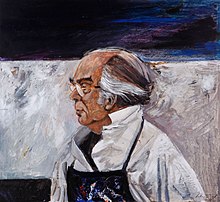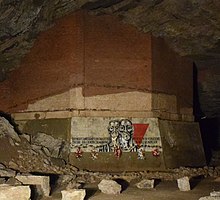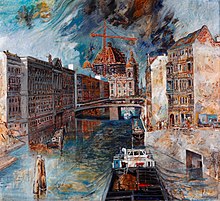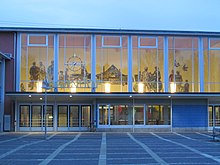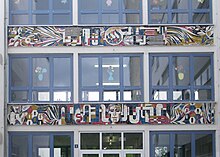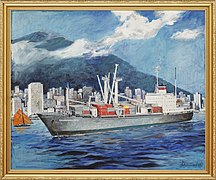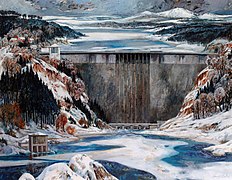Wilhelm Schmied
Wilhelm Schmied (born April 13, 1910 in Dresden , † December 7, 1984 in Sangerhausen ) was a German painter and graphic artist of Socialist Realism .
Life
Wilhelm Schmied was born as the son of a decorative painter in Dresden. He spent his youth in Riesa , attended elementary school there and completed an apprenticeship as a decorative painter and varnisher from 1924 to 1927, followed by journeyman years from 1928. Among other things, he studied a semester at the Nuremberg School of Applied Arts in 1930 and was also a journeyman painter in Nuremberg, Staffelstein and Schkeuditz and received further training at Burg Giebichenstein Halle from Charles Crodel . From 1933 he belonged to the NSDAP . In 1934 he passed his master craftsman examination as a master painter in Halle / Saale and worked as such in Sangerhausen until 1940. During this time he married Johanna Lutze from Schkeuditz in 1934 and gave birth to his daughter Ursula (1936–2014), who later became a painter herself. In 1940 he was drafted into the Wehrmacht and was taken prisoner during the Second World War . After his return he worked again in his painting business. In 1946 he began his freelance work with self-taught training as a painter and graphic artist and worked as a freelancer in Sangerhausen from 1948. In 1947 he joined the Liberal Democratic Party of Germany .
Furthermore, for many years he headed the painting and drawing circle of the “Thomas Müntzer Schacht für Bildnerisches Volksschaff”, which existed from 1954, in which he trained laypeople, workers, housewives and students in the sense of the “ Bitterfelder Weg ”, including the young Einar from 1958 Schleef , and took part in the second Bitterfeld conference in April 1964. In addition to his own artistic work, he was active in various committees and associations, such as in 1965 in the advisory board for fine arts to plan the newly emerging Halle-Neustadt . From 1959 to 1973 Schmied was chairman of the Association of Visual Artists (VBK) in the Halle district . From 1970 Schmied was an extraordinary member of the Academy of Fine Arts of the GDR , from 1974 until his death a full member. Christa Böhme , who attended the Akademie der Künste from 1977 to 1980, was one of his students. His grave is in the cemetery in Sangerhausen.
Artistic creation
Overview and classification
In 1951 Schmied won the competition for the artistic design of the Maxim-Gorki-Theater in Magdeburg , but in 1952 he also designed the windows for Christmas, Good Friday / Easter and Whitsun in the choir of the Jakobikirche in Sangerhausen, and illustrated Christa Wolf's novella from Moscow, published in 1962 by Mitteldeutscher Verlag . He participated in all major exhibitions in the GDR , has received numerous art in architecture -Aufträge he in the style of Socialist Realism explained, but in the early 1970s commissioned to design a monumental mural commemorating the forced laborers in the Heimkehle at Uftrungen . He created a variety of paintings, graphics, decorative plastering on buildings and large-format mosaics . In addition, he was particularly fascinated by the city and landscape views of the Mansfeld region as well as the coastal landscape of the Baltic Sea and the region around Ahrenshoop , which he captured in his extensive work of graphics, watercolors and oil paintings. Schmied also went on study trips to various socialist countries and to Egypt in the 1960s and 1970s, from which he brought a large number of motifs and implemented them in later picture cycles.
Schmied's work was in accordance with the art doctrine of the GDR as an ideologically founded style of art of the 20th century and the specifications of the Kulturbund der GDR . As early as 1954 he explained his views in the article The German Democratic Republic - the foster home of our national humanistic culture and promoter of visual artists in the "Heimatbl Blätter des Kreis Sangerhausen - Kulturspiegel", of which he was a member of the "editorial committee": "The German people demand from the Artists contemporary, realistic works of art. (...) Only the artist, who is connected with the work and the life of his people, can meet the demands of society and create works that are realistic in form and content ”. The organ of the Central Committee of the Socialist Unity Party of Germany (SED) Neues Deutschland described him in 1983 as “a well-defined artist personality in our country, whose profile is unmistakable, and he has made a major contribution to giving the GDR's art its specific, socialist character obtained ". “With his oversized wall mosaics, Schmied quickly became a sought-after artist in the GDR”. As a representative of socialist realism, he was one of “the politically ambitious painters” who were honored with numerous state prizes.
In addition, his works are now mainly of cultural and historical interest. “Schmied's pictures, designed in GDR times, […] are valuable documents that show Sangerhausen from the perspective of an artist under socialism .” He created works “that deal with the copper pits, the miners and the cultural landscape of this region shaped by mining employ". Schmied “played a key role in shaping the visual arts in the GDR. With his industrial landscapes, cityscapes and landscapes he documented the changes brought about by humans and thus became a contemporary witness of a developed industrial society "," a chronicler of the social and economic structural changes that deeply affect the lives of the inhabitants of the towns and villages in the Mansfeld region ".
His works can be found at the Wilhelm Schmied Association for the Promotion of His Artistic Heritage eV, the Academy of Arts Berlin, the Kunsthalle Rostock , the Museum Junge Kunst Frankfurt / Oder, the Schlossmuseum Bernburg , the New Masters Art Collection of the State Art Collections Dresden , in the Museum Weißenfels , in the District Home Museum Bad Frankenhausen , in Burg & Schloss Allstedt and in the Art Museum Moritzburg Halle . The Spengler Museum Sangerhausen owns, among other things, the oil paintings Sangerhäuser Blumenstrauss and Goldene Aue as well as other earlier landscape paintings and still lifes from the time when he painted living room decorations. Many of his commissioned works are stored in archives, such as in the Berlin art depot of the Federal Administration Office , the works from the holdings of the former Mansfeld gallery in the district archive of the district of Mansfeld-Südharz (depot Sangerhausen-Othal), or ten paintings in the Beeskow art archive , which today “ are almost only of cultural and political interest ”.
architectural art
Mainly in Sangerhausen Schmied left lasting traces through his art in construction. Together with Karl Erich Müller he created a series of mosaics and murals, around 1955 the Paracelsus mosaic for the chemical institute of the Martin Luther University Halle-Wittenberg and in 1958 a tile mural for the dining room of the Leuna factory "Walter Ulbricht" . From 1970, following the example of Willi Neubert , he also used industrial email for these orders . Here, colored enamel is applied to steel plates and the resulting enamel plates are assembled into large-scale works.
In 1963 he created a large wall mosaic in the newly built station building in Sangerhausen with motifs based on socialist realism, which can still be viewed today. The “typifying mode of representation characterized by the striving for monumentality” can also be found in this work, which shows handicrafts and professions typical of the city. Another large wall mosaic from 1970 was located in the south-west settlement, near Wilhelm Schmied's studio, at the polytechnic high school named after Juri Alexejewitsch Gagarin (from 1990 until the "Schiller-Gymnasium" was demolished in Sangerhausen). It dealt with the subject of "space travel". When the school was demolished in 2011, the mural, which was already damaged at the time and was not a listed building, was also destroyed. What has been preserved, however, are the sgraffiti typical of the time on the walls of the western settlement “Am Bergmann”, which were made in 1952 by an artist collective around Schmied. They were restored during the city renovation in 2014.
Outside of Sangerhausen, Schmied created a facade mosaic for the Aschersleben shopping mall in 1964, designed the interior walls of the Magdeburg swimming pool in 1965/66 with the mosaic float , and in 1970 designed the main entrance of the Kastanienallee elementary and secondary school in Halle-Neustadt with painting on ceramic tiles Music connects the peoples and 1974 created tile wall pictures for the cafeteria of the Martin Luther University in Halle- Kröllwitz . In 1977 he designed with Die Obstbauern a mural 11 meters high and 5.5 meters wide made of 189 steel plates with enamel glaze on behalf of the fruit growing cooperative VEG "Walter Schneider" for a gable wall of a building in the settlement on "Süßen See" near Eisleben. Schmied's design was carried out in Willi Neubert's workshop in Thale as a specialist in large-format enamel art.
Artistic development and subjects
The Mansfelder Land and the near and far surroundings of his homeland were repeatedly used as motifs. As early as 1949 Schmied participated in the state art exhibition of Saxony-Anhalt with the watercolor over days . Schmied chose motifs such as Sangerhausen in 1955 and Halden bei Eisleben in 1963 (in the holdings of the Dresden State Art Collections, Galerie Neue Meister). During the 1950s and first half of the 1960s, his work was characterized by a sober, predominantly descriptive style of representation. His landscapes as well as the figurative representations are characterized by “clear, self-contained contours”. "Have been through close contact with Halle painters should mainly the pursuit of constructive clarity in compositional structure promoted." This included alongside Willi Sitte and Karl Erich Müller had worked with Smith earlier in the field baugebundener art, which in valley living Willi Neubert . "Tendencies towards typifying generalizations, which began to determine the work of these artists around 1960, also prevailed at Schmied."
Schmied took part in the V art exhibition of the GDR in 1962 with several pictures: his 85 cm × 180 cm oil painting Mansfelder Land attracted a great deal of attention and helped Schmied gain national fame. "Wolferode, the facilities of the Mansfeld mining industry, pits and the huts in Helbra and Eisleben" are shown. For the first time, it “puts a massive mining dump in the context of a vast landscape. The churned-up earth casts ominous shadows on the village in the middle distance, while the view into the distance is blocked by smoking chimneys. The socialist pure title conceals the ambivalent content of the picture. "
The second picture, Discussion of the Mansfeld Miners , was one of the rare artistic contributions “dedicated to the new, self-confident worker personality”. Another picture that was exhibited was August-Bebel-Hütte / Mansfeld landscape “See what power”, which was then passed on to the State Council of the GDR.
Like many of his Halle artist colleagues, such as Heinz Beberniß and Willi Neubert, Schmied followed the developing movement "which led to personal encounters between artists and production brigades" and joined forces in 1963 with the VEB Mansfeld Combine "Wilhelm Pieck" by concluding a friendship agreement . As early as 1949, the Mansfeld Combine had commissioned professional artists “to create works of art in the style of socialist realism”. The resulting collection of 380 works of art was exhibited in the "Mansfeld Gallery". The motifs of Schmied's pictures were the changes in the landscape caused by mining and topics from industrial production. His portrayal of the workers was characterized by the “then widespread turn towards a type portrait that often had ideal features”. In 1969, the combine built a studio for him in Sangerhausen-Südwest, which is still in existence. Schmied's commissioned work included Thomas-Müntzer-Schacht in Sangerhausen from 1959, in the collection of the district of Mansfeld-Südharz, the diptych Miners Today and Tomorrow from 1969 and the triptych People of the Mansfeld Land from 1970. In 1973 Halle-Neustadt was made for the council of the city of Halle / Saale, 1981 Halle - route F 80 , in the inventory of the state administration office Halle.
Study trips to North Korea in 1964, Poland in 1966, Hungary , Romania and Bulgaria in 1967, Finland in 1972, Egypt in 1976, Yugoslavia in 1977 as well as in the CSSR in 1971 and several times between 1959 and 1972 in the USSR gave Schmied impulses for new artistic means of expression. He recorded his impressions in pictures such as Sheravna (Bulgaria) (1966) or the Crimean coast near Gurzuf (1968). From the mid-1960s onwards, his works changed from an "emphatically static conception" to a more dynamic representation. "A new liveliness, which is expressed in the preference for more dynamic forms", became visible in the pictures. Schmied was able to capture "architecture and landscape as a unit" with insights into East Asian culture during his North Korea trip. His choice of colors was also influenced by his travels to southern countries, gained in “luminosity and freshness” and especially the trip to Egypt in 1976 “introduced a new color tone into his painting”, which can be seen in pictures such as the village in the Nidelta and boats on the Nile from 1976 becomes visible.
In addition, Schmied captured the coastal landscapes of the Baltic Sea artistically, around 1965 with fishing boats in Warnemünde . He stayed several times in the period from 1960 to 1980 in the "Intelligence Bath" Ahrenshoop . There he created numerous landscapes from Fischland , for example Althagen (1960), Härtnerei in Wustrow (1963), steep banks near Ahrenshoop (1964), Kate with blossoming trees (1964), farm near Wustrow (1965), steep coast near Ahrenshoop (1972, im Holdings of the State Administration Office Halle), Ahrenshoop (1976) and Ahrenshoop (1979).
"MS Sangerhausen", 1984, ( captain 's picture for the DSR container ship )
Awards
- Handel Prize of the Halle District Council (1962)
- Art Prize of the FDGB for the painting "Halden bei Eisleben" (1963)
- Johannes R. Becher Medal of the GDR (1963)
- Patriotic Order of Merit in bronze (1966), in silver (1975), in gold (1980)
- Art Prize of the GDR (1968)
- National Prize of the GDR (1969)
- Art Prize of the City Council of Halle-Neustadt for the painting "Halle-Neustadt 1973" and his work at the Association of Visual Artists (1973)
- Labor banner , 1976
- Designation of a newly created "Wilhelm-Schmied-Straße" in the northern residential area in the core town of Sangerhausen (2016)
Exhibitions
Since 1949 Wilhelm Schmied has participated with his works in all art exhibitions in the GDR , in the Albertinum in Dresden and in all art exhibitions in the Halle district as well as in national exhibitions in Halle and Leipzig , and in international exhibitions in Moscow , Sofia and Prague . Personnel exhibitions took place from 1969 to 1983 in Halle, Eisleben, Bernburg , Sangerhausen, Weißenfels , Píšťany , Bad Frankenhausen, Berlin, Köthen and Heringsdorf , among others . In 1982 a large exhibition took place in the memorial " Bauernkriegspanorama " in Bad Frankenhausen. In 1983 about 200 works by Schmied were shown in his last major personal exhibition at the Akademie der Künste in the Marstall in Berlin, including most of the Fischland pictures from Ahrenshoop.
Posthumously, on the occasion of his birthday in 1990, a commemorative exhibition took place in the Galerie Junge Kunst (today Städtische Museen Junge Kunst and Viadrina ) Frankfurt / Oder, in 2000 an extensive retrospective with many loans in the Spengler Museum Sangerhausen and in 2010 an exhibition in the Art Kapella Schkeuditz . An association founded in 2014 dedicated to Schmied's work initiated or organized the exhibition “Forgotten Treasures” in his former studio in Sangerhausen Süd-West on the occasion of the 30th anniversary of his death in 2014, and a special trip on the Mansfeld mine railway to im on his 105th birthday Lokschuppen von Hettstedt and in 2018 in the gallery café of the Halloren chocolate factory in Halle the exhibition “Wilhelm Schmied. A life for art - city and landscape views ”.
Schmied's panel pictures (each 180 cm × 140 cm, oil on hardboard) from 1975 - Leunawerke , Rappbode-Talsperre , Mansfelder Schächte - which hung in the conference room of the People's Chamber in the Palace of the Republic , are now in the holdings of the art depot Federal Office of Administration and are part of the exhibition Palace of the Republic - Utopia, Inspiration, Politics in the Kunsthalle Rostock, which is funded by the Federal Cultural Foundation . On display are “works of art that deal with this controversially discussed building. Art that supported the state symbol is juxtaposed with that that critically questioned state decisions ”.
literature
- Christine Hofmeister: Industrial landscape as a statement of the time . In: Bildende Kunst , 1967, pp. 196–200
- Hans Ahr: The Sangerhausen painter and graphic artist Wilhelm Schmied , bibliography, Sangerhausen 1971 (typescript)
- Wolfgang Hütt : What is becoming visible. To new works by Wilhelm Schmied . In: Bildende Kunst , 1969, pp. 228–231
- Wolfgang Hütt: Artists in Halle - World of Art . Henschelverlag Art and Society, Berlin 1977
- Ruth Kraft : Ocher to red in: It seems to me that the guy is glazed - poet on painter . Buchverlag Der Morgen, Berlin 1978, pp. 236–245
- Ingrid Schulze: Wilhelm Schmied , art book series painter and work . VEB Verlag der Kunst, Dresden 1980
- Wilhelm Schmied painting and graphics . (Ed. By the Academy of the Arts of the GDR on the exhibition "Wilhelm Schmied, Painting and Graphics" from January 14th - February 27th 1983 in the exhibition rooms of the Akademie im Marstall, Berlin), Berlin: Akademie der Künste, 1983
Web links
Individual evidence
- ↑ Einar Schleef. The painter . Michael Freitag, Katja Schneider (eds.), DuMont Buchverlag, 2008, p. 11, ISBN 978-3-8321-9089-7
- ↑ a b c d e f g h i hallelife.de: Exhibition opening - Wilhelm Schmied “A life for art” on April 17, 2018. Accessed on November 12, 2019
- ↑ Harry Waibel : Servants of many masters. Former Nazi functionaries in the Soviet Zone / GDR. Peter Lang, Frankfurt am Main a. a. 2011, ISBN 978-3-631-63542-1 , p. 295.
- ↑ Blacksmith and chocolate: works by the Sangerhausen painter can be seen at Halloren . In: Focus online June 24, 2018. Retrieved November 11, 2019
- ↑ a b c d e f g h Ingrid Schulze: Wilhelm Schmied , art book series painter and work . VEB Verlag der Kunst, Dresden 1980, pp. 26-27
- ^ Wilhelm Schmied, contribution to the discussion at the II. Bitterfeld Conference: People should love our art. Ed .: Fine Arts, 8/1964. 1964, p. 407-410 .
- ↑ Wolfgang Behrens: Einar Schleef. Work and person . Theater der Zeit, Berlin 2003, p. 20
- ↑ Einar Schleef: Diary 1953–1963 . Edited by Winfried Menninghaus , Wolfgang Rath, Johannes Windrich and Einar Schleef. Suhrkamp Verlag, Frankfurt am Main 2004, ISBN 3-518-41605-7 , p. 285.
- ↑ Linn Settimi: Plea for the tragic: choir and femininity figures in Einar Schleef . transcript Verlag, Bielefeld 2018, ISBN 978-3-8376-4630-6 , p. 18
- ^ Academy of Arts: Fine Arts - Members . Retrieved November 12, 2019
- ↑ Christa Böhme. In: Entry in the picture atlas Art in the GDR . Retrieved February 11, 2020 .
- ↑ Ev. St. Jacobi parish: building history & tour . Retrieved November 15, 2019
- ↑ German Biographical Encyclopedia (DBE). Schlumberger - Thiersch . Rudolf Vierhaus (Ed.), 2nd edition, KG Saur Verlag, Munich 2008, p. 66 , ISBN 978-3-598-25030-9
- ↑ a b c d e f g h i Ralf Poschmann: Mayor's report on the 5th city council meeting on December 4, 2014 . In: Sangerhäuser Nachrichten, Official Bulletin for the City of Sangerhausen from December 19, 2014, Sangerhausen / Südharz, Volume 10, Number 24/2014, pp. 2-3. Retrieved November 12, 2019
- ^ State Office for Monument Preservation and Archeology Saxony-Anhalt: Reports on Monument Preservation 2018 , p. 82 , 2019
- ^ Wilhelm Schmied: The German Democratic Republic - the foster home of our national humanistic culture and promoter of visual artists . In: Heimatblätter des Kreis Sangerhausen , Kulturbund for the democratic renewal of Germany, district leaders Sangerhausen and Artern in connection with the councils of the district, department culture. - Sangerhausen (Ed.), Nationales Aufbauwerk 1954, October 1954 edition, part 4
- ↑ Ullrich Kuhirt: Man and landscape, shaped by creative work . In: Neues Deutschland from February 2, 1983
- ^ Beate Lindner: Wilhelm-Schmied-Verein in Sangerhausen. The climbing studio is painting again . In: Mitteldeutsche Zeitung of November 14, 2014. Retrieved November 12, 2019
- ↑ a b Hildtrud Ebert, Jutta Penndorf in collaboration with Matthias Flügge : opinion on the existence of the Art Archive Beeskow . On behalf of the Ministry for Science, Research and Culture (MWFK) of the State of Brandenburg, Berlin and Altenburg, July 2014, pp. 12, 14 and 18
- ^ A b c Wolfgang Hütt : Artists in Halle . Henschelverlag Art and Society, Berlin 1977, license no. 414.235 / 61/77. LSV no. 8116, book page 44
- ↑ Jana Lehmann, Marion Schatz: Leuna between reconstruction and the turning point 1945-1990 . State Main Archive Saxony-Anhalt (Ed.), Erfurt 2006, ISBN 978-3-86680-024-3 , p. 44
- ↑ a b c d e f g h i Ingrid Schulze: Wilhelm Schmied , art book series painter and work . VEB Verlag der Kunst, Dresden 1980, pp. 2-7
- ↑ Cornelia Heller: A strong piece of Eastern modernism . In: Deutsche Bauzeitung dated February 7, 2017. Retrieved October 30, 2019
- ^ Beate Lindner: Sangerhausen: Mosaic drives Sangerhäuser. In: Mitteldeutsche Zeitung. January 14, 2011, accessed November 14, 2019 .
- ^ Beate Lindner: Commentary on the Wilhelm Schmied exhibition: A prelude. In: Mitteldeutsche Zeitung. December 5, 2014, accessed November 14, 2019 .
- ↑ Monika Frohriep: Sangerhausen . Sutton Verlag, Erfurt 2004, ISBN 978-3-89702-706-0 , p. 36 ( google.de [accessed November 15, 2019]).
- ^ Association of State Monument Preservators in the Federal Republic of Germany. Structural engineering working group: "Tailor-made" Energetic upgrading of architectural monuments . Brochure accompanying the Leipzig Monument Fair, 2012, pp. 40–41
- ↑ Daniela Messerschmidt: Are Schmied's fruit growers coming home? . In: Wochenspiegel from October 23, 2015. Accessed November 25, 2019
- ↑ a b Virtual Gallery Dresden: Wilhelm Schmied, Mansfelder Land, 1962. Retrieved on November 9, 2019 .
- ^ Bildatlas: Art in the GDR: Art in the GDR. Halden near Eisleben . Retrieved November 12, 2019
- ↑ Ulrich Kuhirt: drama and poetry of the landscape. To the picture “Halden bei Eisleben” by Wilhelm Schmied . In: Fine Arts , 1964, p. 137
- ↑ Property of the Federal Republic of Germany / Art Archive, currently included on loan in a research project of the Dresden State Art Collection.
- ↑ Heimatverein Wolferode: picture panel presented . Retrieved October 30, 2019
- ^ Anja Hertel: Wolfgang Mattheuer. The political landscape , pp. 3-4. In: Federal Foundation for the Processing of the SED Dictatorship . Retrieved November 14, 2019
- ↑ since 2016 in the portfolio of the Wilhelm Schmied Association for the Promotion of His Artistic Heritage eV
- ^ Wolfgang Hütt: Artists in Halle . Henschelverlag Art and Society, Berlin 1977, license no. 414.235 / 61/77. LSV no. 8116, p. 8
- ↑ today owned by the district of Mansfeld-Südharz
- ^ Daniela Messerschmidt: Real treasures from the Mansfeld gallery - a blacksmith is also there . In: Wochenspiegel from September 10, 2015. Retrieved November 25, 2019
- ↑ Oliver Sukrow, Lucian Hölscher: work. Living. Computer: On utopia in the fine arts and architecture of the GDR in the 1960s . Heidelberg University Publishing 2018, ISBN 978-3947732098 , pp. 350–352
- ^ Ahrenshoop intelligence pool . Journal for the History of Ideas Issue XII / 2 Summer 2018. Ulrich von Bülow, Peter Burschel, Luca Giuliani, Hermann Parzinger, Ulrich Raulff, Hellmut Seemann (eds.), Within the framework of the Marbach Weimar Research Association Wolfenbüttel, Kösel, Krugzell, ISBN 978 3 406 71862 5
- ^ A b Friedrich Schulz: Ahrenshoop artist lexicon . Verlag Atelier im Bauernhaus, Fischerhude 2001, ISBN 978-3-88132-292-8 , pp. 156–157
- ^ Bildatlas: Art in the GDR: Art in the GDR. Seeburg on the Süßen See near Lutherstadt Eisleben . Retrieved November 12, 2019
- ^ Tobias Kühnel: An art prize from Neustadt? Or: How culture was “built” 50 years ago. In: City history page in the Kulturfalter , July / August 2014, on the website of the Association for Halle City History . Retrieved November 12, 2019
- ^ Sangerhauser Nachrichten - Official bulletin for the city of Sangerhausen: Announcement of the city of Sangerhausen about the naming of a street in the core city of Sangerhausen . Sangerhausen / Südharz, Volume 12, July 12, 2016, Number 13/2016, p. 8
- ^ Waldemar Haase: Wilhelm Schmied 1910–1984 . Exhibition booklet. Ed .: Galerie Junge Kunst. Frankfurt / Oder 1990.
- ↑ Panorama Museum Bad Frankenhausen (ed.): Wilhelm Schmied painting graphic . Exhibition catalog IV / 21/5 Pa 212/82. Bad Frankenhausen 1982.
- ↑ prometheus - The distributed digital image archive for research and teaching : Image series 24/2019: Palace of the Republic . Retrieved November 12, 2019
- ^ German Historical Museum: Landscape paintings in the conference rooms of the Volkskammer . Retrieved November 25, 2019
- ↑ Kunsthalle Rostock: Palace of the Republic . Retrieved November 12, 2019
| personal data | |
|---|---|
| SURNAME | Smith, Wilhelm |
| BRIEF DESCRIPTION | German painter and graphic artist |
| DATE OF BIRTH | April 13, 1910 |
| PLACE OF BIRTH | Dresden |
| DATE OF DEATH | 7th December 1984 |
| Place of death | Sangerhausen |
